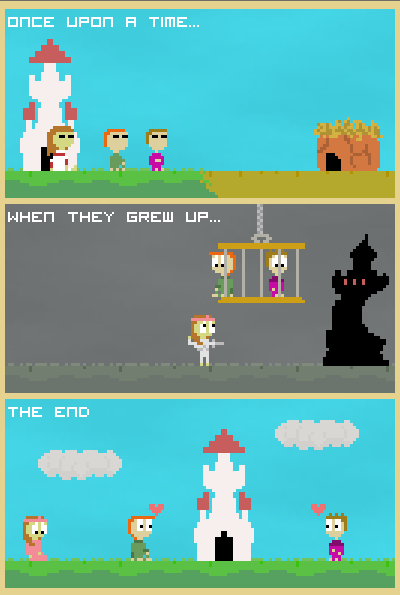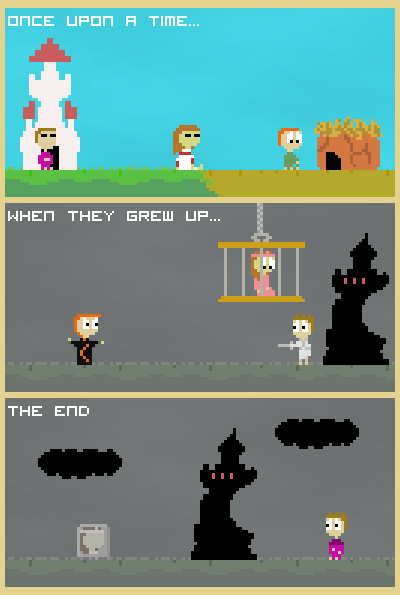Retro Replay Review
Gameplay
Storyteller introduces a simple yet deeply engaging mechanic built around three interactive vignettes displayed side by side. Players can drag and drop two boys and one girl character into any of the “Once Upon a Time,” “When They Grew Up,” and “The End” panels. Each placement shifts the narrative immediately, letting you see the effects of your choices in real time. This accessibility makes it easy for newcomers to jump right in, while offering enough depth to keep experienced players experimenting.
(HEY YOU!! We hope you enjoy! We try not to run ads. So basically, this is a very expensive hobby running this site. Please consider joining us for updates, forums, and more. Network w/ us to make some cash or friends while retro gaming, and you can win some free retro games for posting. Okay, carry on 👍)
The absence of the photography-based mechanic found in earlier Moon Stories titles streamlines the experience, focusing purely on character placement and narrative branching. Every small change—moving a character from one panel to another—can send the story spiraling in unexpected directions. This emphasis on immediate cause and effect encourages creative play, as you’re constantly motivated to explore alternative scenarios and uncover hidden endings.
What truly sets Storyteller’s gameplay apart is its replayability. With only three characters and three vignettes, you might think the permutations are limited, but dozens of unique endings await discovery. Whether you’re steering the protagonists toward triumph or tragedy, each playthrough feels fresh. The learning curve is gentle, yet mastering the interplay between panels to craft coherent—or delightfully chaotic—stories provides lasting satisfaction.
Graphics
Visually, Storyteller adopts a minimalist, storybook-inspired art style that evokes classic fairy tales without feeling dated. Each vignette uses a restrained color palette, allowing characters and key environmental elements to stand out. The clean lines and soft gradients are pleasing to the eye, creating an inviting stage for your narrative experiments.
Character designs are charming and expressive, despite their simplicity. The two boys and the girl each have subtle visual cues—posture, facial expression, attire—that communicate mood and personality. When you drag them between vignettes, a slight animation plays, reinforcing the tactile satisfaction of interacting directly with the story.
Backgrounds transition smoothly to reflect narrative changes. For example, moving a character into the “When They Grew Up” panel might darken the sky or transform a peaceful village into a stormy battleground. These dynamic environmental touches, though modest, enhance immersion by mirroring the emotional tone you’ve set through your choices.
Story
At its core, Storyteller is a meta-narrative experiment. The three vignettes—“Once Upon a Time,” “When They Grew Up,” and “The End”—represent classic story stages, yet what happens within them is entirely up to you. This framework gives the narrative a familiar structure while granting complete freedom over its unfolding, from budding friendship to tragic conflict or even unexpected romance.
The branching possibilities are surprisingly rich. You might start with a sweet childhood scene, then deliberately introduce tension in the middle act by placing both boys into the same panel, setting up rivalry. Or you can thrust all three characters into the final chapter, producing a swift, bittersweet conclusion. Every decision resonates across panels, inviting you to think not just about individual scenes but about how they interconnect.
Despite lacking dialogue or traditional cutscenes, Storyteller conveys emotion through imagery and context. The game trusts you to assemble the narrative threads, making each revelation—be it a joyful reunion or a heartrending farewell—feel earned. As you piece together character arcs and outcomes, you become both author and audience, discovering hidden depths in a story you helped create.
Overall Experience
Storyteller offers a uniquely playful approach to interactive fiction. Its simple drag-and-drop mechanic hides a wealth of narrative potential, rewarding curiosity and experimentation. Whether you’re a seasoned gamer seeking innovative mechanics or a newcomer drawn to visual storytelling, you’ll find plenty to enjoy here.
The title’s strengths lie in its immediacy and replay value. There’s no inventory to manage or intricate puzzles to solve—just pure, hands-on storytelling. This streamlined design ensures that every session remains engaging, without overwhelming you with complex controls or steep learning curves. Each playthrough unlocks new combinations, encouraging you to revisit familiar characters and scenes from fresh perspectives.
For potential buyers, Storyteller represents an enticing blend of simplicity and depth. It’s a game that sparks creativity and invites multiple replays, making it an excellent addition for anyone interested in narrative-driven experiences. Though concise, its open-ended structure and charming presentation leave a lasting impression, proving that the most memorable stories can emerge from the smallest of canvases.
 Retro Replay Retro Replay gaming reviews, news, emulation, geek stuff and more!
Retro Replay Retro Replay gaming reviews, news, emulation, geek stuff and more!








Reviews
There are no reviews yet.